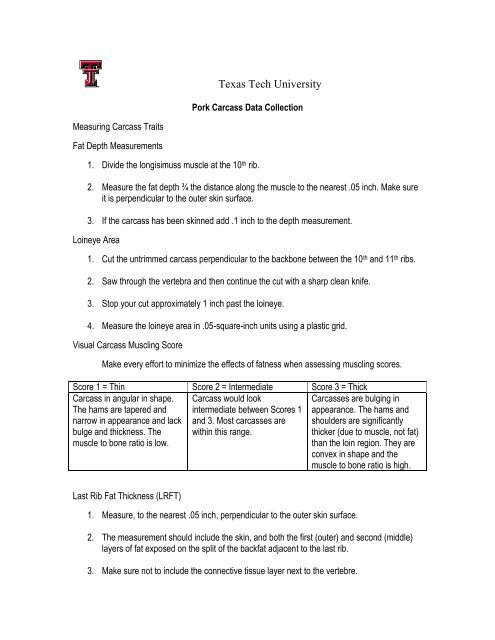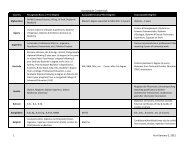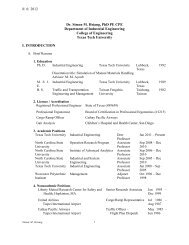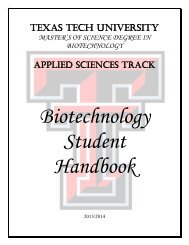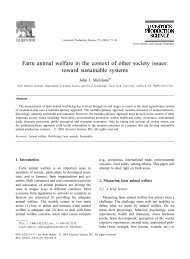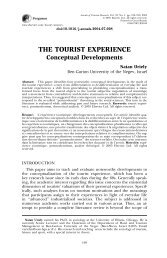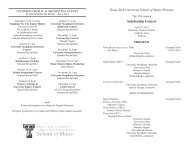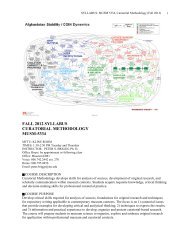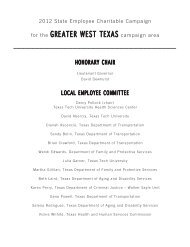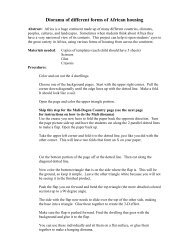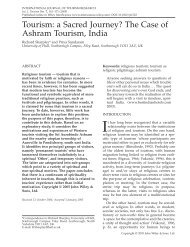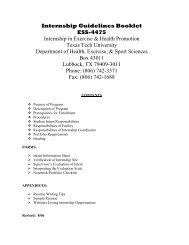Pork Carcass Data Collection - Texas Tech University
Pork Carcass Data Collection - Texas Tech University
Pork Carcass Data Collection - Texas Tech University
Create successful ePaper yourself
Turn your PDF publications into a flip-book with our unique Google optimized e-Paper software.
<strong>Texas</strong> <strong>Tech</strong> <strong>University</strong><br />
<strong>Pork</strong> <strong>Carcass</strong> <strong>Data</strong> <strong>Collection</strong><br />
Measuring <strong>Carcass</strong> Traits<br />
Fat Depth Measurements<br />
1. Divide the longisimuss muscle at the 10 th rib.<br />
2. Measure the fat depth ¾ the distance along the muscle to the nearest .05 inch. Make sure<br />
it is perpendicular to the outer skin surface.<br />
3. If the carcass has been skinned add .1 inch to the depth measurement.<br />
Loineye Area<br />
1. Cut the untrimmed carcass perpendicular to the backbone between the 10 th and 11 th ribs.<br />
2. Saw through the vertebra and then continue the cut with a sharp clean knife.<br />
3. Stop your cut approximately 1 inch past the loineye.<br />
4. Measure the loineye area in .05-square-inch units using a plastic grid.<br />
Visual <strong>Carcass</strong> Muscling Score<br />
Make every effort to minimize the effects of fatness when assessing muscling scores.<br />
Score 1 = Thin Score 2 = Intermediate Score 3 = Thick<br />
<strong>Carcass</strong> in angular in shape.<br />
The hams are tapered and<br />
narrow in appearance and lack<br />
bulge and thickness. The<br />
muscle to bone ratio is low.<br />
<strong>Carcass</strong> would look<br />
intermediate between Scores 1<br />
and 3. Most carcasses are<br />
within this range.<br />
<strong>Carcass</strong>es are bulging in<br />
appearance. The hams and<br />
shoulders are significantly<br />
thicker (due to muscle, not fat)<br />
than the loin region. They are<br />
convex in shape and the<br />
muscle to bone ratio is high.<br />
Last Rib Fat Thickness (LRFT)<br />
1. Measure, to the nearest .05 inch, perpendicular to the outer skin surface.<br />
2. The measurement should include the skin, and both the first (outer) and second (middle)<br />
layers of fat exposed on the split of the backfat adjacent to the last rib.<br />
3. Make sure not to include the connective tissue layer next to the vertebre.
<strong>Carcass</strong> Length<br />
1. Measure (to the nearest .1 inch) the length in as straight line as possible.<br />
2. Start at the cranial (anterior) tip of the aitchbone and measure to the cranial edge of the<br />
first rib and next to the thoracic vertebra.<br />
Adjusted Hot <strong>Carcass</strong> Weight<br />
1. This measurement is for the hot carcass weight of the pork carcass if the skin is attached<br />
and no dressing defects have occurred.<br />
2. If trim loss is estimated to be less than 5%, estimate the amount missing and adjust the hot<br />
carcass weight.<br />
3. Adjust skinned carcasses to a skin-on basis by dividing the hot carcass weight by .94.<br />
4. If chilled rather then hot carcass weights are used, divide the chilled weight by .985 (or<br />
provide a value by the plant that reflects the shrinkage during the initial chilling).<br />
Determination of Quality Grade<br />
1. Evaluate the color of the lean in the skirt, primary flank, secondary flank, intercostal<br />
muscles, lumbar lean surface and Semimbranosus surface of the ham. Acceptable quality<br />
for the numerical grades is grayish-pink to moderately dark red color.<br />
Score<br />
Color Standards<br />
1.0 Pale pinkish gray to white<br />
2.0 Grayish pink<br />
3.0 Reddish pink<br />
4.0 Dark reddish pink<br />
5.0 Purplish red<br />
6.0 Dark purplish red<br />
2. Evaluate the thickness and firmness of the belly. Minimum acceptable quality for the<br />
numerical grades is slightly thick (at least .6 inches in thickness), slightly firm, not soft or<br />
oily, and suitable for bacon production.<br />
Determination of Acceptable or Unacceptable Quality<br />
1. Quality of lean is best evaluated by the direct observation of the characteristics of the<br />
loineye muscle at the 10 th rib.<br />
2. For carcasses with minimum acceptability of lean quality the cut surface will be slightly<br />
firm, have a slight amount of marbling, and be grayish-pink to moderately dark red in color.
3. If a cut surface is not available to determine quality acceptability, this can be determined<br />
indirectly using firmness of fat and lean, amount of feathering between the ribs and color of<br />
lean.<br />
4. For intact carcasses the minimum acceptability is indicated by a slight amount of<br />
feathering between the ribs, fat and lean that is slightly firm and a grayish-pink to dark red<br />
color.<br />
5. Belly thickness must be slightly thick with a minimum of .6 inches of thickness at any point.<br />
6. Color, texture and exudation groups:<br />
PSE RFN DFD NFN<br />
Pale pinkish-gray, very<br />
soft, and exudative.<br />
Reddishish-pink, firm,<br />
and non-exudative.<br />
Dark purplish-red, very<br />
firm and dry.<br />
Reddish-pink, firm and<br />
non exudative.<br />
Undesirable<br />
appearance and<br />
shrinks excessively.<br />
Desirable color,<br />
firmness and waterholding<br />
capacity.<br />
Firm and sticky<br />
surface, high waterholding<br />
capacity.<br />
Firm, fine texture with<br />
a normal water holding<br />
capacity.<br />
Assignment of the Numerical Grade<br />
1. 1,2,3 or 4 preceded by the quality designation, U.S.; U.S. Utility carcasses are not<br />
assigned cutability grades.<br />
Grade<br />
U.S. No. 1<br />
U.S. No. 2<br />
U.S. No. 3<br />
U.S. No. 4<br />
Yield<br />
60.4 percent and over<br />
57.4 to 60.3 percent<br />
54.4 to 57.3 percent<br />
Less than 54.4 percent<br />
2. Measure the fat thickness opposite the last rib in inches (including the skin).<br />
Preliminary Grade<br />
U.S. No. 1<br />
U.S. No. 2<br />
U.S. No. 3<br />
U.S. No. 4<br />
Fat Thickness Range<br />
Less than 1.00 inch<br />
1.00 to 1.24 inches<br />
1.25 to 1.49 inches<br />
1.50 inches and over*<br />
* <strong>Carcass</strong> with last rib fat thickness of 1.75 inches or over cannot be graded U.S. No. 3, even with thick muscling.<br />
3. Evaluate the degree of muscling by appraisal of the muscle to bone ratio in the ham, loin<br />
and shoulder regions and assign a muscling score (thin = 1, average = 2, thick = 3).<br />
4. Using the last rib fat thickness (LRFT) and muscling score, calculate the numerical grade<br />
by the following formula:<br />
<strong>Carcass</strong> Grade = (4.0 X LRFT) – (1.0 X Muscling Score)


